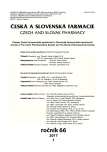Cytotoxické, protirakovinné a antimikrobiální účinky extraktů z Artemisia rupestris
Authors:
Shamshabanu Nokerbek; Zuriyadda Sakipova; Marta Chalupová; Marcela Nejezchlebová; Jan Hošek
Published in:
Čes. slov. Farm., 2017; 66, 15-22
Category:
Original Articles
Overview
Artemisia rupestris je součástí tradiční kazašské medicíny. Výtažky získané z této rostliny se používají k léčbě různých onemocnění včetně rakoviny. Tato studie hodnotí antimikrobiální, cytotoxické a protirakovinné účinky různých extraktů z této rostliny. Byly použity různé extrakční metody a výsledné biologické aktivity byly navzájem porovnány. Extrakty z A. rupestris byly připraveny z květů a listů, a ze stonků. Byla testována antimikrobiální aktivita proti Candida albicans a Staphylococcus aureus. Pro vyhodnocení cytotoxického potenciálu extraktů byly použity buněčné linie L1210 a THP-1. Vodný extrakt ze stonků byl nejúčinnější proti C. albicans, zatímco růst S. aureus inhiboval nejvíce methanolický extrakt z květů a listů. Vodné extrakty nevykazovaly cytotoxický účinek ani u jedné buněčné linie na rozdíl od lipofilních extraktů. Testované extrakty nevykazovaly účinek proti rakovině in vivo. Získané výsledky svědčí o relativně bezpečném použití vodných výluhů z A. rupestris, lipofilní extrakty vykazují toxické účinky, a proto je při jejich užití potřeba více opatrnosti.
Klíčová slova:
L1210 buněčná linie • THP-1 buněčná linie • mikrovlnná extrakce • ultrazvuková extrakce • Candida albicans • Staphylococcus aureus
Sources
1. Wei X., Aibai S. Progresses in the research of Artemisia rupestris L. Chin. Nat. Pharm. J. 2008; 6, 61–66.
2. Yu D. Q. Recent results on structural chemistry of new natural products from Chinese herbal medicine. Pure and Appl. Chem. 1998; 70, 431–434.
3. Wei X., Aibai S., Li Z. J. Study on the anti-inflammatory effect of the extract of Artemisia rupestris L. Lishizhen Med. Mat. Med. Res. 2008; 19, 2836–2838.
4. Wang R. Kazakh folk medicine. Urumqi, China: Xinjiang Science-technical Publishing House 2008.
5. Hou J., Dong H., Yan M., Zhu F., Zhang X., Wang H., Ye W., Li P. New guaiane sesquiterpenes from Artemisia rupestris and their inhibitory effects on nitric oxide production. Bioorg. Med. Chem. Lett. 2014; 24, 4435–4438.
6. Liu X. C., Li Y. P., Li H. Q., Deng Z. W., Zhou L., Liu Z. L., Du S. S. Identification of repellent and insecticidal constituents of the essential oil of Artemisia rupestris L. aerial parts against Liposcelis bostrychophila Badonnel. Molecules 2013; 18, 10733–10746.
7. Yong J., Lu C., Aisa H. A. Advances in studies on the rupestonic acid derivatives as anti-influenza agents. Mini Rev. Med. Chem. 2013; 13, 310–315.
8. Batay Z. Xinjiang medicinal plants. Urumqi, China: Xinjiang Science-technical Publishing House 2006.
9. Carlo B., Carlotta F., Tommaso S. Essential oils of three Asiatic Artemisia species. Photochemistry 1985; 24, 2440–2442.
10. Su Z., Wu H., Yang Y., Aisa H. A., Slukhan U., Aripova S. Preparative isolation of guaipyridine sesquiterpene alkaloid from Artemisia rupestris L. flowers using high-speed counter-current chromatography. J. Sep. Sci. 2008; 31, 2161–2166.
11. Zhen S., Han K. W., He F., Slukhan U., Aisa H. A. New Guaipyridine Sesquiterpene Alkaloids from Artemisia rupestris L.. Helv. Chim. Acta 2010; 93, 33–38.
12. Gu D., Yang Y., Abdulla R., Aisa H. A. Characterization and identification of chemical compositions in the extract of Artemisia rupestris L. by liquid chromatography coupled to quadrupole time-of-flight tandem mass spectrometry. Rapid Commun. Mass Spectrom. 2012; 26, 83–100.
13. He F., Aisa H. A., Shakhidoyatov K. M. Flavones from Artemisia rupestris. Chem. Nat. Compd. 2012; 48, 685–686.
14. Xie Z. Y., Lin T. T., Yao M. C., Wan J. Z., Yin S. Unusual Guaiane Sesquiterpenoids from Artemisia rupestris. Helv. Chim. Acta 2013; 96, 1182–1187.
15. Razzaghi-Abyaneh M., Rai M. Antifungal Metabolites from Plants. Berlin, Germany: Springer-Verlag Berlin Heidelberg 2013.
16. Poiată A., Tuchiluş C., Ivănescu B., Lazăr M. I. Antibacterial activity of some Artemisia species extract. Rev. Med. Chir. Soc. Med. Nat. Iasi 2009; 113, 911–914.
17. Karabegović I., Nikolova M., Veličković D., Stojičević S., Veljković V., Lazić M. Comparison of Antioxidant and Antimicrobial Activities of Methanolic Extracts of the Artemisia sp. Recovered by Different Extraction Techniques. Chin. J. Chem. Eng. 2011; 19, 504–511.
18. Hall I. H., Tolmie C. E., Barnes B. J., Curtis M. A., Russell J. M., Finn M. G., Grimes R. N. Cytotoxicity of tantalum(V) and niobium(V) small carborane complexes and mode of action in P388 lymphocytic leukemia cells. Appl. Organomet. Chem. 2000; 14, 108–118.
19. Evans M. A., Smith D. C., Holub J. M., Argenti A., Hoff M., Dalglish G. A., Wilson D. L., Taylor B. M., Berkowitz J. D., Burnham B. S., Krumpe K., Gupton J. T., Scarlett T. C., Durham Jr. R. W., Hall I. H. Synthesis and cytotoxicity of substituted ethyl 2-phenacyl-3-phenylpyrrole-4-carboxylates. Arch Pharm (Weinheim) 2003; 336, 181–190.
Labels
Pharmacy Clinical pharmacologyArticle was published in
Czech and Slovak Pharmacy

2017 Issue 1
Most read in this issue
- Osudy židovských farmaceutů z českých zemí během holocaustu
- Zdravotnické a nezdravotnické náklady na léčbu a péči Parkinsonovy choroby – srovnání Evropy, USA, Asie a Austrálie
- Samoemulgující systém (SEDDS) pro podání léčiva ibuprofen: hodnocení vzorků v podmínkách in vitro a in vivo
- Cytotoxické, protirakovinné a antimikrobiální účinky extraktů z Artemisia rupestris
